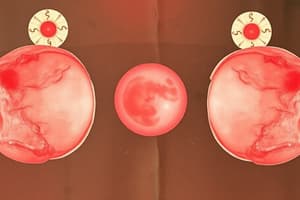Podcast
Questions and Answers
What is a common characteristic of follicular ovarian cysts?
What is a common characteristic of follicular ovarian cysts?
- They often appear as multiple cysts. (correct)
- They are always large over 10 cm.
- They can rarely secrete estrogen. (correct)
- They arise from ruptured graafian follicles.
Which of the following is NOT a criterion for the diagnosis of Polycystic Ovary Syndrome (PCOS)?
Which of the following is NOT a criterion for the diagnosis of Polycystic Ovary Syndrome (PCOS)?
- Hyperandrogenism
- Oligomenorrhea/anovulation
- High levels of estrogen (correct)
- Polycystic ovaries on ultrasound
What type of ovarian tumor is classified as a germ cell tumor?
What type of ovarian tumor is classified as a germ cell tumor?
- Granulosa-theca cell tumor
- Serous tumor
- Dysgerminoma (correct)
- Mucinous tumor
What age group is at the highest risk for PID and oophoritis?
What age group is at the highest risk for PID and oophoritis?
Which statement regarding serous tumors is accurate?
Which statement regarding serous tumors is accurate?
Luteal cysts are lined by which type of cells?
Luteal cysts are lined by which type of cells?
What is typically required for diagnosing PCOS?
What is typically required for diagnosing PCOS?
What is a defining feature of chocolate cysts (endometriotic cysts)?
What is a defining feature of chocolate cysts (endometriotic cysts)?
Which of the following tumors is classified as a sex-cord stromal tumor?
Which of the following tumors is classified as a sex-cord stromal tumor?
Which of the following statements is true about oophoritis?
Which of the following statements is true about oophoritis?
What characterizes a serous cystadenoma microscopically?
What characterizes a serous cystadenoma microscopically?
Which feature is NOT associated with papillary serous cystadenocarcinoma?
Which feature is NOT associated with papillary serous cystadenocarcinoma?
What distinguishes borderline serous tumors from benign forms?
What distinguishes borderline serous tumors from benign forms?
Which characteristic is typical of mucinous cystadenoma?
Which characteristic is typical of mucinous cystadenoma?
Which type of tumor is primarily associated with endometriosis?
Which type of tumor is primarily associated with endometriosis?
What is the major component distinguishing mature teratomas?
What is the major component distinguishing mature teratomas?
What complication is NOT common for benign serous and mucinous cystadenomas?
What complication is NOT common for benign serous and mucinous cystadenomas?
How do Brenner tumors typically appear grossly?
How do Brenner tumors typically appear grossly?
Which condition is indicative of malignancy in mucinous cystadenocarcinoma?
Which condition is indicative of malignancy in mucinous cystadenocarcinoma?
What characteristic is shared by borderline forms of tumors?
What characteristic is shared by borderline forms of tumors?
What is the primary age group for the occurrence of immature (malignant) teratoma?
What is the primary age group for the occurrence of immature (malignant) teratoma?
Which microscopic feature is characteristic of dysgerminoma?
Which microscopic feature is characteristic of dysgerminoma?
Which tumor is associated with Meigs syndrome?
Which tumor is associated with Meigs syndrome?
What is a significant characteristic of granulosa-theca cell tumors?
What is a significant characteristic of granulosa-theca cell tumors?
What is the typical presentation of a Krukenberg tumor?
What is the typical presentation of a Krukenberg tumor?
Which feature is a defining characteristic of sex cord-stromal tumors?
Which feature is a defining characteristic of sex cord-stromal tumors?
What percentage of granulosa-theca cell tumors are potentially malignant?
What percentage of granulosa-theca cell tumors are potentially malignant?
Which type of tumor is described as bulky and solid, with areas of necrosis and hemorrhage?
Which type of tumor is described as bulky and solid, with areas of necrosis and hemorrhage?
What type of tissue is NOT typically found in monodermal teratomas?
What type of tissue is NOT typically found in monodermal teratomas?
What is a common histological feature of fibroma-thecomas?
What is a common histological feature of fibroma-thecomas?
Flashcards
Oophoritis
Oophoritis
Inflammation of one or both ovaries, often a complication of pelvic inflammatory disease (PID).
Pelvic Inflammatory Disease (PID)
Pelvic Inflammatory Disease (PID)
Inflammation and infection in the upper female reproductive tract (uterus, tubes, and ovaries).
Follicular Ovarian Cyst
Follicular Ovarian Cyst
A non-cancerous cyst that forms from an unruptured follicle on the ovary. Often multiple and can grow large, but usually small.
Luteal Cyst
Luteal Cyst
Signup and view all the flashcards
Chocolate Cyst (endometriotic cyst)
Chocolate Cyst (endometriotic cyst)
Signup and view all the flashcards
Polycystic Ovary Syndrome (PCOS)
Polycystic Ovary Syndrome (PCOS)
Signup and view all the flashcards
Surface Epithelial Tumors
Surface Epithelial Tumors
Signup and view all the flashcards
Serous Tumor
Serous Tumor
Signup and view all the flashcards
Serous Cystadenoma
Serous Cystadenoma
Signup and view all the flashcards
Germ Cell Tumors
Germ Cell Tumors
Signup and view all the flashcards
Papillary Serous Cystadenocarcinoma
Papillary Serous Cystadenocarcinoma
Signup and view all the flashcards
Borderline Serous Tumor
Borderline Serous Tumor
Signup and view all the flashcards
Mucinous Cystadenoma
Mucinous Cystadenoma
Signup and view all the flashcards
Mucinous Cystadenocarcinoma
Mucinous Cystadenocarcinoma
Signup and view all the flashcards
Borderline Mucinous Tumor
Borderline Mucinous Tumor
Signup and view all the flashcards
Endometrioid Tumor
Endometrioid Tumor
Signup and view all the flashcards
Brenner Tumor
Brenner Tumor
Signup and view all the flashcards
Teratoma
Teratoma
Signup and view all the flashcards
Sex Cord Stromal Tumor
Sex Cord Stromal Tumor
Signup and view all the flashcards
Granulosa-theca Cell Tumor
Granulosa-theca Cell Tumor
Signup and view all the flashcards
Fibroma-thecoma
Fibroma-thecoma
Signup and view all the flashcards
Sertoli-Leydig Cell (Androblastoma) Tumor
Sertoli-Leydig Cell (Androblastoma) Tumor
Signup and view all the flashcards
Immature Teratoma
Immature Teratoma
Signup and view all the flashcards
Struma Ovarii
Struma Ovarii
Signup and view all the flashcards
Dysgerminoma
Dysgerminoma
Signup and view all the flashcards
Metastatic Ovarian Tumor
Metastatic Ovarian Tumor
Signup and view all the flashcards
Krukenberg Tumor
Krukenberg Tumor
Signup and view all the flashcards
Monodermal Teratoma
Monodermal Teratoma
Signup and view all the flashcards
Study Notes
Ovarian Disorders
-
Inflammation of the ovary (oophoritis): Oophoritis occurs when one or both ovaries become inflamed, often preceded by infection of fallopian tubes or peritoneum. It's part of chronic pelvic inflammatory disease (PID), affecting the upper genital tract (uterus, tubes, and ovaries). Females under 35 are at highest risk. It rarely develops before menstruation, during pregnancy, or after menopause. Extensive fibrosis can cause sterility.
-
Non-neoplastic cysts of ovary (Follicular ovarian cysts): Very common, arising from unruptured ovarian follicles. Often multiple, can grow large (over 10cm) but are usually small (approximately 1.5 cm). The lining resembles a normal follicle (granulosa and theca cells). They rarely secrete estrogen.
-
Luteal cysts: Cysts in the corpus luteum, approximately 2 cm in diameter (up to 3 cm). Usually multiple and lined by luteal cells. Secretes progesterone.
-
Chocolate cyst (endometriotic cyst): A specific type of cyst.
-
Germinal inclusion cyst: Cyst resulting from germinal epithelium development into ovarian stroma.
-
Polycystic ovary syndrome (PCOS): A common condition in 12-21% of women of reproductive age. Up to 70% remain undiagnosed. More prevalent in obese women. Can cause infertility. Requires two of three criteria for diagnosis: oligomenorrhea/anovulation, hyperandrogenism (hirsutism, raised free androgen index/free testosterone), and polycystic ovaries on ultrasound.
Ovarian Tumors
Classification of ovarian tumors:
-
Surface epithelial tumors: Serous, mucinous, Brenner, endometrioid, clear cell tumors
-
Clinicopathological features of surface epithelial tumors (Serous tumors): Show a significant proportion of benign cases (60%), with malignant cases (25%), and borderline (15%).
-
Serous cystadenoma: Grossly, they are small to large (up to 40cm) rounded masses with smooth walls. They're often unilateral, and unilocular, filled with clear yellowish fluid. Microscopic features include a single layer of tall columnar ciliated cells with small microscopic papillae.
-
Papillary Serous cystadenocarcinoma: Grossly, they exhibit solid papillary projections invading the cyst wall. Microscopically, they have more than one layer of cells showing malignancy characteristics, and may contain psammoma bodies.
-
Borderline serous tumors: Grossly similar to benign, microscopically similar to malignant without involvement of the stromal tissue.
-
Mucinous tumors: Benign cases (mucinous cystadenoma = roughly 80%) and malignant (mucinous cystadenocarcinoma = roughly 5-10%), with a borderline form.
-
**Mucinous cystadenoma: ** Large ovoid, lobulated, usually unilateral, multilocular, gelatinous material fills the cyst. Thick and fibrous walls. Microscopically, tall columnar cells with apical mucinous vacuolation.
-
Mucinous cystadenocarcinoma: Shows atypia in cells with invasion of the capsule and the presence of solid formations.
-
Endometrioid tumors: Approximately 20% of ovarian cancers, associated with ovarian endometriosis (50%). Gross characteristics show solid and cystic areas; 40% are bilateral. Microscopically, resembles endometrial adenocarcinoma.
-
Brenner tumors: Mostly benign, unilateral, and occasionally cystic. Varies from smaller lesions up to large masses. Dense fibrous stroma and nests of transitional cells.
-
Germ cell tumors: Teratomas (mature and immature) and dysgerminoma.
-
Teratomas (mature): Mostly cystic, small, called dermoid cysts; Lined with skin, hair, and sebaceous glands. Microscopically they are composed of epidermis, hair follicles, sebaceous glands, teeth, cartilage, bone, thyroid tissue, as well as other organ tissue. Malignant change (squamous cell carcinoma) in rare cases (1%).
-
Teratomas (immature): Bulky, solid tumors with necrosis and hemorrhage. Immature cells differentiating into cartilage, glands, bone, muscle, or nerves.
-
Dysgerminoma: Ovarian counterpart of seminoma. Usually in childhood, teens, or twenties. Solid, fleshy, yellowish-white to gray-pink; 90% are unilateral tumours. Microscopically, large cells with clear cytoplasm in sheets with scant fibrous stroma. Lymphocytes can be present.
-
Sex-cord stromal tumors: Arise from embryonic gonads or ovarian stroma. Frequently functional, secreting estrogen (granulosa or theca cell tumors) or androgen (Sertoli-Leydig cell tumor).
-
Granulosa-theca cell tumor: Common in postmenopausal women. Unilateral, solid and cystic areas. Usually encapsulated. Potentially malignant (5–25%).
-
Microscopically: Mixture of granulosa and theca cells. Granulosa cells in cords, sheets, or strands (rosettes). Theca cells are spindle-shaped with lipid droplets.
-
Fibroma-thecomas: Usually unilateral, solid, hard tumours. Well-differentiated fibroblasts. Often associated with hydrothorax/ascites (Meigs syndrome).
-
Sertoli-Leydig cell tumor: Produce androgens. Usually unilateral. Composed of Sertoli or Leydig cells.
-
Metastatic tumors: Primarily from gastrointestinal tract or breast. Krukenberg tumor is a bilateral metastatic ovarian cancer typically originating in the stomach's malignant cells spread throughout the peritoneal cavity.
Complications of benign ovarian cysts
- Torsion: Twisting of a pedicle leading to hemorrhage
- Rupture: leading to acute abdomen
- Pressure effects.
- Malignant change
Studying That Suits You
Use AI to generate personalized quizzes and flashcards to suit your learning preferences.



